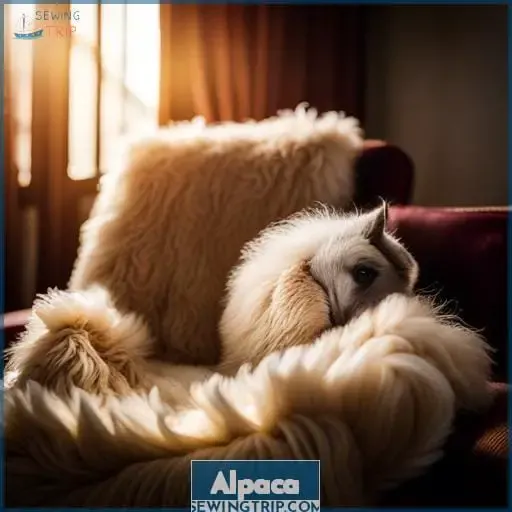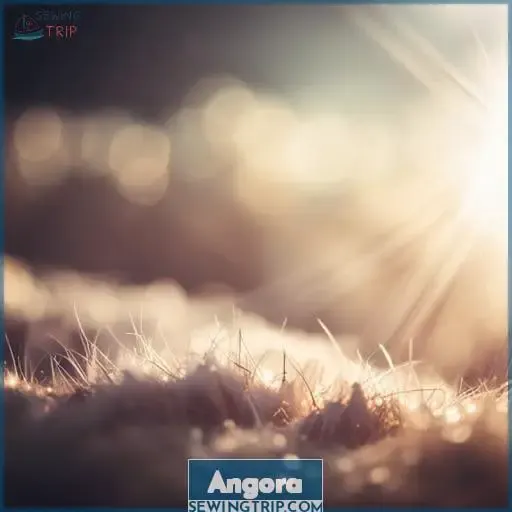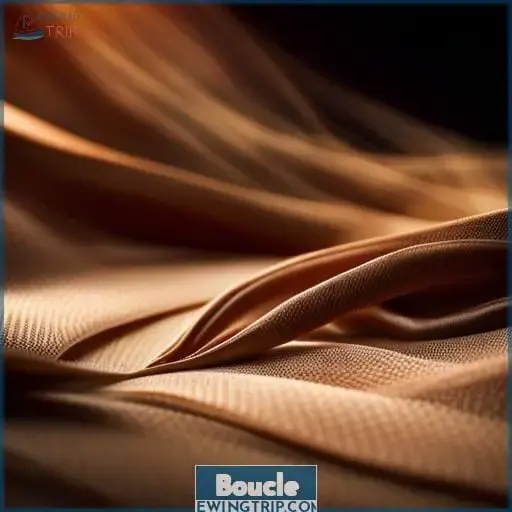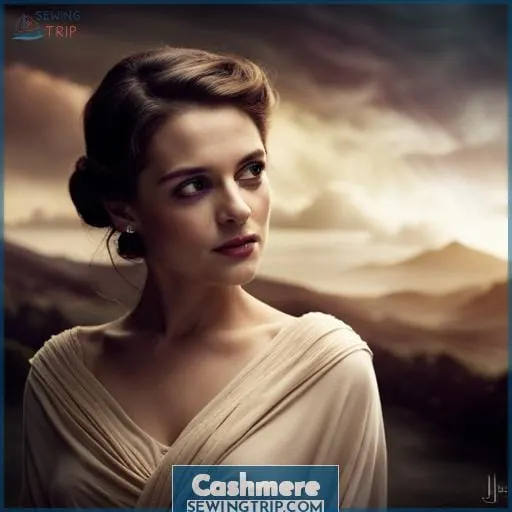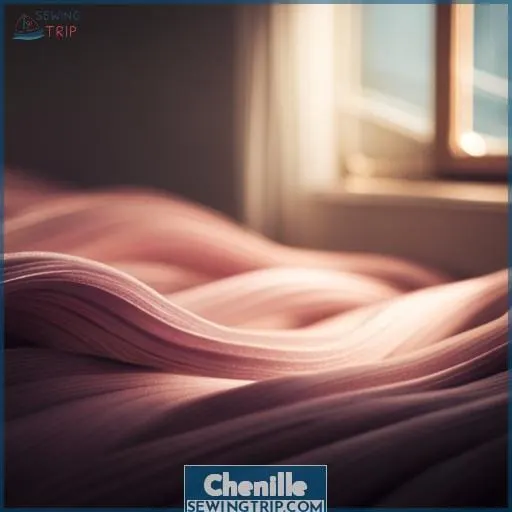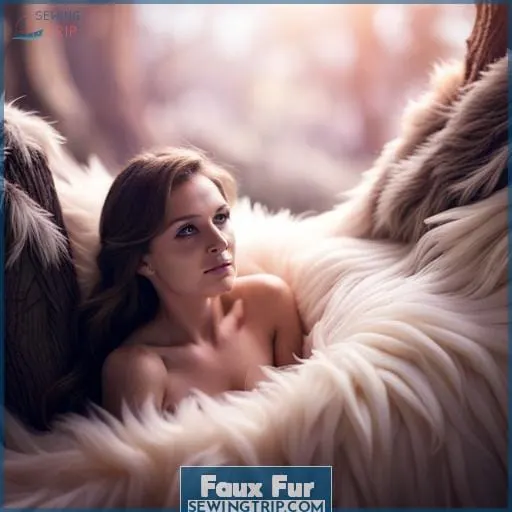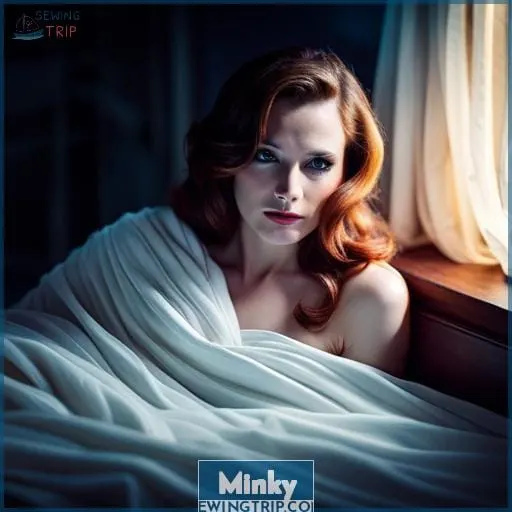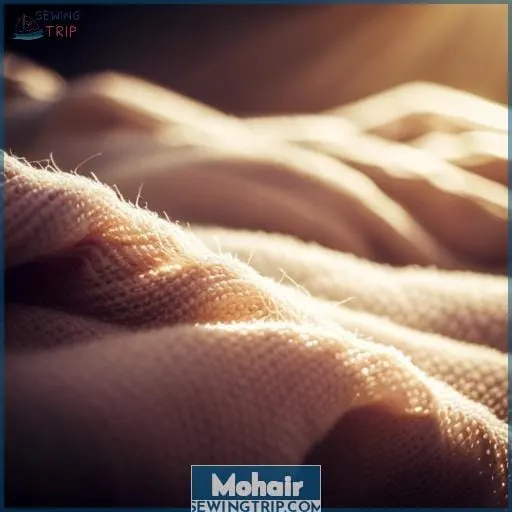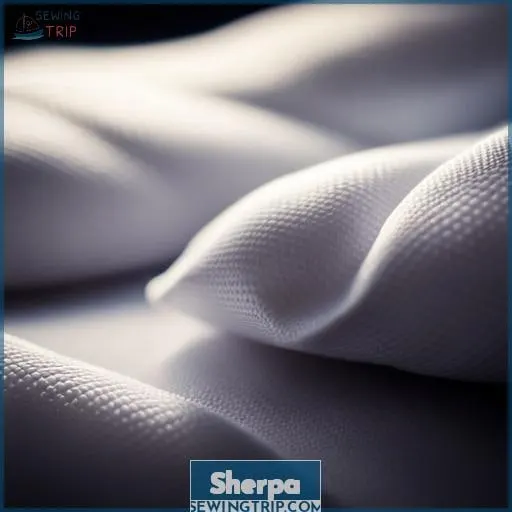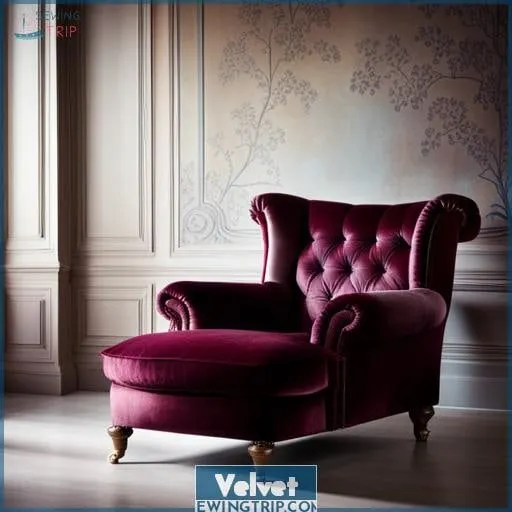This site is supported by our readers. We may earn a commission, at no cost to you, if you purchase through links.
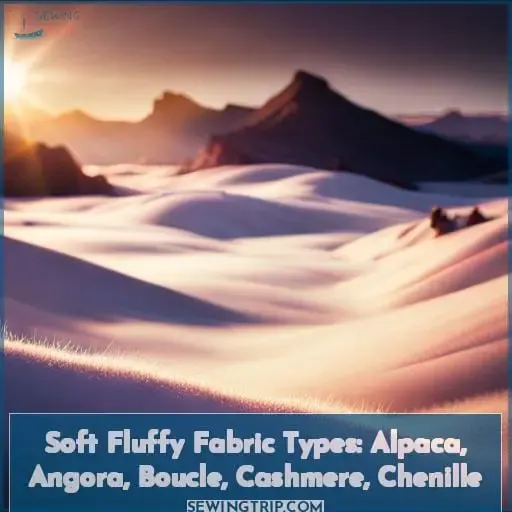 Imagine wrapping yourself in a cloud, cocooned in the softest, fluffiest embrace.
Imagine wrapping yourself in a cloud, cocooned in the softest, fluffiest embrace.
- Alpaca
- Angora
- Boucle
- Cashmere
- Chenille
Each one offers its own unique texture and warmth that will leave you feeling like royalty.
Table Of Contents
Key Takeaways
- Alpaca, Angora, and Cashmere are all animal-sourced fibers known for their exceptional softness and warmth.
- Bouclé and Chenille are two fabric types that offer unique textures and appearances.
- Alpaca, Angora, and Cashmere are commonly used in sweaters and scarves, while Bouclé and Chenille are versatile for various garments and accessories.
- Ethical practices and sustainable sourcing are emphasized in the production of Angora and Cashmere.
Alpaca
If you’re looking for a soft and warm fabric, alpaca is an excellent choice.
Sourced from South American alpacas, this fluffy material is known for its luxurious softness and exceptional warmth.
It can be processed into yarn for weaving or knitting, making it ideal for creating cozy clothing items like sweaters and scarves.
Softness and Warmth
If you’re looking for a fabric that offers exceptional softness and warmth, alpaca is the perfect choice.
Alpaca fibers are sourced from South American alpacas, known for their luxurious softness and insulating properties.
When it comes to assessing softness, alpaca surpasses other fabrics like angora or cashmere.
Its warmth comparison is unmatched due to its hollow fiber structure that provides excellent insulation against cold temperatures.
Additionally, choosing alpaca supports sustainable practices and has cultural significance in South American communities.
Sourced From South American Alpacas
Alpaca, sourced from South American alpacas, offers a soft and warm fabric for various applications.
When it comes to sourcing alpaca fabric, ethical practices are paramount. Ensuring fair treatment of the animals and supporting sustainable farming methods is essential.
Additionally, considering the environmental impact of alpaca farming can help promote responsible choices in the industry.
Artisan techniques play a significant role in creating high-quality alpaca fabric through skilled craftsmanship and attention to detail during fiber processing.
Implementing sustainability measures further enhances the value of this luxurious natural fiber choice.
Angora
Angora is a luxurious fabric known for its renowned softness and warmth. It’s gathered from Angora rabbits, making it a natural and sustainable option.
This fabric can be spun into yarn for weaving or knitting, commonly used in the creation of sweaters and scarves that provide exceptional comfort during colder seasons.
Renowned Softness and Warmth
When it comes to softness and warmth, Angora fabric is highly regarded in the textile industry. Its renowned softness and luxurious feel make it a top choice for those seeking ultimate sensory comfort.
Crafters and fashion designers alike appreciate the elegant touch that Angora brings to their creations. Whether you’re knitting cozy sweaters or crafting plush scarves, this fluffy fabric provides unparalleled warmth analysis combined with a study of unmatched softness.
Gathered From Angora Rabbits
You can gather Angora, a soft and fluffy fabric type, from Angora rabbits.
When it comes to sourcing this luxurious material, ethical practices are crucial. Ensuring sustainability and prioritizing animal welfare are key considerations in the industry.
Fiber harvesting techniques play a significant role in maintaining the quality of Angora fabric. Additionally, artisanal techniques contribute to its unique texture and appearance.
These factors collectively contribute to the durability and appeal of plush toy fabrics made from Angora.
Boucle
Boucle is a soft and fluffy fabric that stands out due to its distinctive texture. It’s composed of various fibers, giving it a unique appearance with loops or curls throughout the fabric.
As a textile engineer, fashion designer, or fabric store owner, you can appreciate boucle for its versatility in creating stylish garments and accessories that offer both comfort and visual interest.
Distinctive Texture
Continuing with our exploration of soft and fluffy fabric types, let’s delve into the distinctive texture of boucle.
- Texture Exploration
- Textile Variations
- Tactile Sensation
Boucle fabric is known for its looped or curled yarns that create a textured surface resembling small loops or knots. Its irregular composition adds visual interest and depth to garments, making it a popular choice for cozy sweaters and blankets.
Composed of Various Fibers
To explore the distinctive texture of boucle, let’s delve into its composition of various fibers.
Fiber blending and material fusion are key elements in creating this unique fabric. The mixed composition results in diverse textures that add depth and interest to any garment or home decor item made from boucle.
With a blend variety of soft, fluffy fabrics available, you have endless options for creating cozy blankets or adorable plushies.
Cashmere
Cashmere is a luxuriously soft fabric that’s derived from the cashmere goat. Known for its exceptional warmth and delicate texture, cashmere is highly sought after in the fashion industry. With its fine fibers carefully harvested and processed, garments made from this exquisite fabric provide unparalleled comfort and elegance to those who wear them.
Luxuriously Soft
As we delve further into the realm of soft and fluffy fabrics, let’s explore the luxurious and highly sought-after fabric known as cashmere.
-
Cozy Comfort
Indulge in unparalleled comfort with a garment made from plush cashmere fibers that cocoon you like a warm hug on chilly days.
-
Sensory Delight
Experience pure sensory bliss as your fingers glide over velvety smooth strands, delighting both touch receptors and aesthetic senses simultaneously.
-
Plush Elegance
Step into an aura of opulence draped elegantly around you when wearing clothing crafted from sumptuous cashmere threads that exude timeless luxury.
-
Soft Splendor
Bask in sheer splendor by adorning yourself or decorating your living space with irresistibly silky-soft textiles woven meticulously using fine-grade Cashmeri goats’ undercoat hairs to create an unmatchable tactile experience
-
Sumptuous Texture
Immerse yourself in ultimate indulgence through garments boasting rich texture created by intertwining delicate yet robust strands for resiliently sumptuous results
Derived From the Cashmere Goat
You can find cashmere, a luxuriously soft and fluffy fabric, derived from the wool of the Cashmere goat.
Certainly, fiber extraction is an important process in obtaining this premium material.
Various goat breeds produce different qualities of cashmere wool for spinning techniques.
The luxury market highly values cashmere for its exceptional warmth and comfort.
Sustainable sourcing ensures ethical practices in acquiring this precious fabric.
Explore faux fur as an alternative or consider shearling, mohair, velvet, or cotton for similar textures and styles.
Chenille
Chenille is a soft and fluffy fabric known for its fuzzy and velvety texture. It’s often made from cotton or synthetic fibers, which contribute to its plush feel.
Chenille fabrics can be used in various applications, including:
- Upholstery
- Blankets
- Clothing items like scarves and sweaters
- Home decor accents such as pillows and throws
Fuzzy and Velvety Texture
Get cozy with the fuzzy and velvety texture of chenille fabric.
- Fiber Sourcing: Chenille is often made from cotton or synthetic fibers.
- Textile Processing: It undergoes a unique manufacturing process to achieve its plush appearance.
- Crafting Techniques: Chenille is perfect for creating soft blankets, cozy scarves, and luxurious pillows.
- Fabric Maintenance: To keep your chenille fabric in top condition, follow proper cleaning instructions to preserve its fluffy texture.
Often Made From Cotton or Synthetic Fibers
Chenille fabric, known for its fuzzy and velvety texture, is often made from cotton or synthetic fibers. This versatile material offers a wide range of options when it comes to texture variety.
Whether you prefer the softness of natural animal-sourced fibers like alpaca or angora, or the convenience and durability of synthetic alternatives, chenille can be produced using various production techniques to achieve different fabric characteristics.
So go ahead and explore the wonderful world of chenille fabrics!
Faux Fur
Now, let’s talk about faux fur – the perfect fabric for achieving a plush and fluffy appearance without using real animal fur.
Faux fur is an imitation fabric made from polyester that replicates the softness and texture of natural furs like mink or fox. It provides a luxurious look to garments, accessories, and home decor items while being more affordable and ethically conscious.
Imitation Fur Fabric
Feel the luxurious softness and enjoy a fluffy appearance with imitation fur fabric, also known as faux fur. This versatile fabric is perfect for creating cozy DIY creations like blankets, scarves, and hats.
- Stylish seasonal trends
- Affordable price point
- Easy to sew with fluffy fabrics like polyester or faux suede.
- Simple maintenance hacks for washing and caring for your fluffy fabric creations
Provides a Plush and Fluffy Appearance
If you’re looking for a fabric that provides a plush and fluffy appearance, faux fur is the perfect choice.
Faux fur offers the luxurious look and feel of real animal fur without any harm to animals.
It adds instant warmth and coziness to any space or outfit, making it popular in home decor and fashion trends.
With its soft texture and versatility, faux fur is an excellent option for creating stylish accents in your designs or adding a touch of luxury to your living space.
Minky
Minky, a super soft and cuddly fabric, is often sought after for its luxurious feel. It’s commonly used in making baby blankets and toys due to its gentle touch against delicate skin.
With its fluffy texture and cozy appeal, Minky fabric provides the perfect combination of comfort and style for your little ones.
Super Soft and Cuddly
If you’re looking for a fabric that’s super soft and cuddly, minky is the perfect choice.
- Made from high-quality polyester fibers.
- Manufactured using advanced weaving techniques.
- Ideal for creating plush toys and baby blankets.
- Machine washable with cold water to maintain its softness.
Stay on-trend with this cozy and squishy fabric!
Often Used for Baby Blankets and Toys
For those looking to create soft and cuddly baby blankets and toys, minky fabric is often the go-to choice. This plush and fluffy material is perfect for crafting cozy items that provide comfort to little ones.
With its irresistibly soft texture, minky fabric has become a popular option in recent baby blanket trends. Whether you’re making DIY plush toys or snuggly blankets, minky fabric will surely delight both babies and parents alike.
| MINKY FABRIC |
|---|
| Softness |
| Plush Texture |
| Durability |
Mohair
Mohair is a soft and lustrous fabric that’s collected from the Angora goat.
Known for its luxurious texture and sheen, Mohair is a popular choice for creating elegant garments such as sweaters, scarves, and coats.
Its natural insulation properties make it ideal for keeping warm during colder seasons while still maintaining comfort and style in your fashion choices.
Soft and Lustrous
Continue the exploration of soft and fluffy fabric types by delving into the luxurious world of mohair, known for its softness and lustrous appeal.
Mohair, sourced from Angora goats, offers a delightful combination of durability and elegance. Its long fibers give it a silky texture that adds sophistication to any garment or home decor item.
Whether you’re looking for angora varieties or faux fur trends, mohair is a fantastic choice that brings both comfort and style to your projects.
Collected From the Angora Goat
To continue our exploration of soft and lustrous fabrics, let’s delve into Mohair – a luxurious material collected from the Angora goat.
Known for its exceptional fiber characteristics, Mohair is prized for its softness, sheen, and durability.
This exquisite fabric can be used to create various items such as Alpaca yarn or blended with other fibers to produce unique textures like Boucle.
With proper care akin to Angora rabbit care guidelines, you can enjoy the plush comfort of Mohair in your fashion creations or home decor projects.
Sherpa
Sherpa is a soft and fluffy fabric that resembles sheep’s wool. It’s known for its cozy texture and warmth, making it ideal for winter garments and accessories.
As a textile engineer or fashion designer, understanding the characteristics of Sherpa can help you create comfortable and stylish pieces that will keep your customers snug during the colder months.
Cozy and Fluffy
Snuggling up in Sherpa is like experiencing a warm embrace. This cozy textile trend has become a staple for fluffy decor inspirations and softness in fashion.
Its plush texture provides warmth at home, making it perfect for blankets, pillows, and even clothing items like jackets and slippers.
Crafters also love working with Sherpa fabric to create plush fabric crafts such as st■ animals or cozy accessories that bring comfort and joy to everyday life.
Resembles Sheep’s Wool
When snuggling up in a cozy blanket, you’ll love the softness and warmth of Sherpa fabric, which resembles sheep’s wool.
With its high pile texture, Sherpa adds an element of coziness to any garment or home decor item. Whether used as lining for jackets or blankets for chilly nights, Sherpa fabric offers both practicality and luxury that’s sure to keep you warm and stylish all year round.
Velvet
Are you looking for a fabric that combines softness and luxury with a plush and velvety texture? Look no further than velvet! This versatile fabric is perfect for adding elegance and sophistication to any space or outfit.
Here are five reasons why velvet should be your go-to choice:
- Velvet Upholstery: Transform your furniture into luxurious pieces with velvet upholstery, creating an inviting and opulent atmosphere in your home.
- Velvet Fashion: Stay on-trend by incorporating velvet into your wardrobe, whether it’s a sleek blazer, a glamorous evening gown, or trendy accessories like shoes or bags.
- Velvet Home Decor: From curtains to pillows to bedding, use velvet in home decor accents to elevate the style of any room in your house.
- Velvet Trends: Keep up with the latest fashion trends by embracing the resurgence of vintage-inspired designs featuring richly colored velvets.
- Velvet Care: Maintain the beauty of this delicate fabric by using gentle cleaning methods such as spot-cleaning spills promptly and avoiding harsh chemicals.
With its sumptuous feel and timeless appeal, there’s no doubt that owning anything made from luxurious velvet will add an extra touch of decadence to your life.
Frequently Asked Questions (FAQs)
What are the best fabric types for creating plush toys that have a soft and fluffy texture?
For plush toys with a soft, fluffy texture, consider using fabrics like fleece and minky.
These materials offer the desired squishiness and are perfect for creating cuddly companions that will bring joy to both children and adults alike.
Are there any specific fabric types that are hypoallergenic and suitable for individuals with allergies or sensitivities?
Looking for hypoallergenic fabric options? You’re in luck!
Check out natural fibers like cotton and alpaca, known for their softness and allergy-friendly properties.
These fabrics will keep you cozy and comfortable without any sneeze-inducing surprises!
What are the key characteristics and qualities of cashmere fabric that make it so highly regarded?
Cashmere fabric is highly regarded for its luxurious softness, warmth, and lightweight feel. It’s sourced from cashmere goats and known for its insulating properties. A perfect choice for cozy sweaters or scarves that will make you fall in love with the touch of cashmere against your skin.
Can you provide some examples of clothing or accessories that are commonly made using boucle fabric?
Boucle fabric is a versatile choice for creating stylish clothing and accessories. It adds texture and visual interest to items like jackets, skirts, and handbags.
Are there any special care instructions or considerations for maintaining and cleaning minky fabric?
To keep your minky fabric looking its best, treat it like a treasured heirloom.
Gently hand wash with a mild detergent and air dry to preserve its softness and fluffiness for years to come.
Conclusion
To wrap up, these soft fluffy fabric types – Alpaca, Angora, Boucle, Cashmere, and Chenille – offer the ultimate in luxury and comfort.
Whether you’re looking for warmth on a chilly night or adding a touch of elegance to your wardrobe or home decor projects, these fabrics are perfect.
From the softness and warmth of Alpaca and Angora to the distinctive texture of Boucle, each fabric has its own unique qualities.
So indulge yourself in the softness and fluffiness of these fabrics, and feel like royalty every day.

